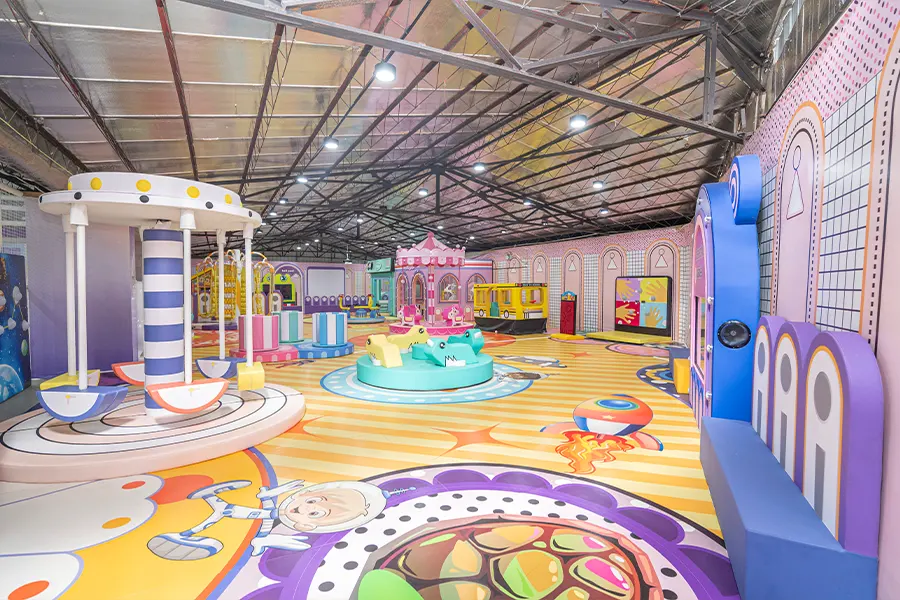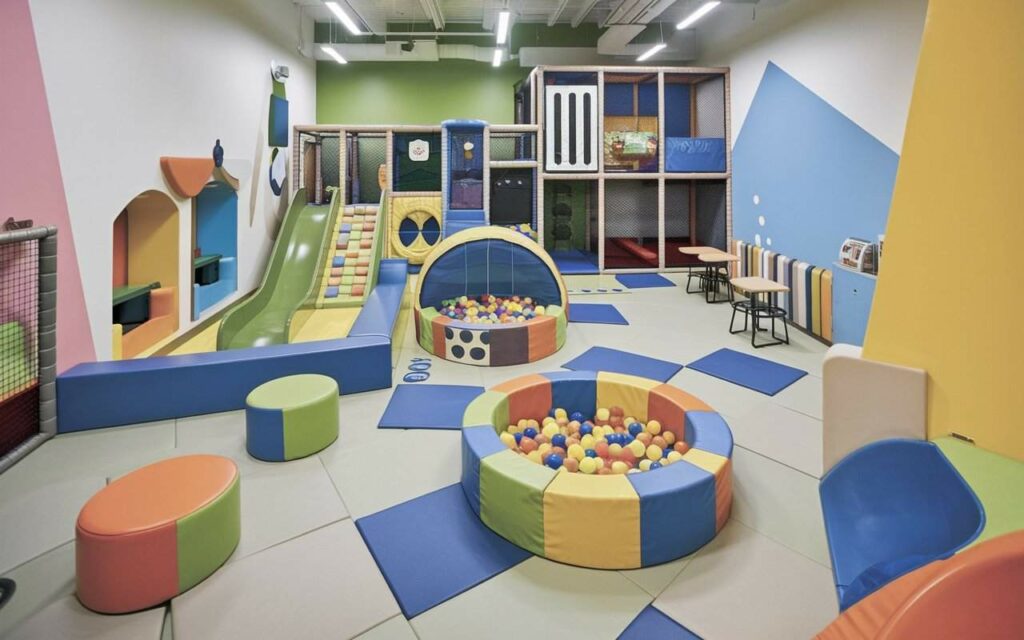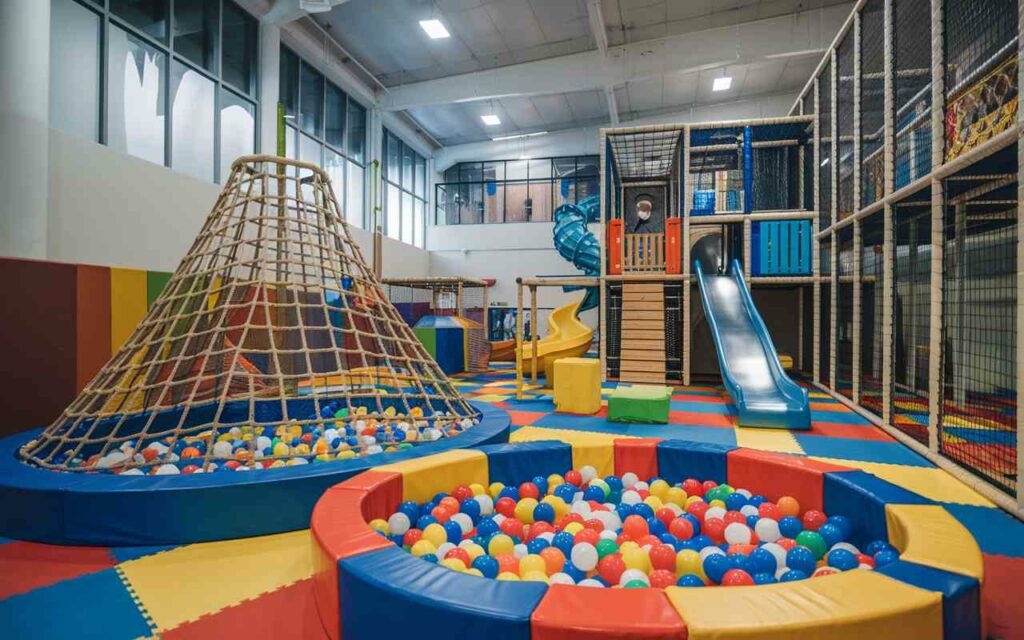Indoor playgrounds are a haven for kids, providing them with a space to run wild, have fun, and develop their physical and social skills. But ensuring these playgrounds are safe is crucial. Let’s explore why indoor playground safety is important and what common risks to watch out for.

1. Understand Safety Standards and Regulations
Safety standards and regulations are key. Do you know why? The Consumer Product Safety Commission (CPSC) reports that over 200,000 children visit emergency rooms yearly due to playground injuries. Scary, right? That’s why compliance with standards from bodies like ASTM is non-negotiable.
These guidelines cover everything from equipment spacing to surfacing materials. For example, the ASTM recommends that swings should be at least 24 inches apart to prevent collisions. Surfacing materials should have a minimum depth of 12 inches to cushion falls effectively. Think of these guidelines as the rulebook for a safe playground—follow them, and you create a fun, safe environment where kids can play without parents constantly worrying.
2. Choose the Right Location
The right location for your indoor playground is also paramount. Research shows that having clear zones around play equipment reduces collision risks by 30%. Therefore, you may assess the venue for potential hazards like sharp corners, exposed wires, and slippery floors. Ensure adequate space to avoid overcrowding, which can lead to accidents.
3. Design a Safe Playground Layout
A safe playground layout and design is like setting up the perfect living room—everything needs its place to avoid chaos. First, create clear pathways to ensure kids can move freely without bumping into each other. Separate active play zones (like slides and climbing walls) from quieter areas (like reading nooks or art stations). This reduces the risk of accidents and keeps the energy balanced.
Then, avoid overcrowding by spacing out equipment. For instance, swings should be at least 24 inches apart and have a clear fall zone of at least 6 feet in all directions. This helps prevent collisions and gives kids room to play safely. This way, kids can easily navigate the space without tripping or running into obstacles. A well-thought-out layout is the backbone of a safe, enjoyable playground.
4. Select Safe Playground Equipment
Not all indoor playground equipment is created equal, like indoor climbing walls and trampoline parks. A study found that playgrounds with age-appropriate, certified equipment have 30% fewer injuries. Therefore, start by prioritizing age-appropriate gear. Toddlers need smaller, lower structures with gentle slides and soft surfaces, while older kids crave more challenging equipment like climbing walls and monkey bars.
その上, look for equipment with smooth edges and sturdy construction. Avoid any with pinch points or sharp edges that could cause injuries. Also, ensure that all equipment is securely anchored to the ground to prevent tipping. Safe, certified, and age-appropriate equipment is like picking the right ingredients for a recipe—get it right, and you’ve got a perfect, safe playground for kids to enjoy.
5. Implement Soft Surfacing
The type of surfacing material you choose can significantly impact safety. Soft, shock-absorbing surfaces like rubber mats, foam padding, or artificial turf can cushion falls and prevent serious injuries. It’s like adding a layer of bubble wrap underfoot, giving kids a safe landing spot.
6. Ensure Proper Installation
According to the National Program for Playground Safety (NPPS), improper installation is a leading cause of playground injuries, accounting for about 20% of incidents. This means that proper installation of playground equipment is non-negotiable for safety.
Start by hiring certified installers who know the ins and outs of playground setup. These pros ensure everything is anchored securely and assembled correctly. Before letting kids loose, conduct thorough pre-use inspections. Check that bolts are tightened, equipment is stable, and there are no sharp edges or loose parts. Proper installation and maintenance are the cornerstones of a safe playground where kids can play freely and parents can relax.
7. Ensure Equipment Safety Features
Guardrails, barriers, safety mats, and cushions are not optional—they’re essential. These features prevent falls and provide additional safety for active play. Incorporating these elements is like putting up safety nets for a trapeze artist.
8. Address Special Needs
Inclusivity is key in modern playground design. You may design play spaces that are accessible to children with disabilities. This includes ramps for wheelchairs, sensory play equipment, and quiet zones for children who might be overwhelmed by too much sensory input. It’s about creating a space where every child feels welcome.
9. Regular Maintenance
Regular inspections are crucial to catch potential hazards before they become accidents waiting to happen. According to the Centers for Disease Control and Prevention (CDC), routine maintenance can reduce playground-related injuries by up to 50%. It’s like catching a leaky faucet before it floods your kitchen—small problems are easier to fix before they escalate.
Inspect high-use areas daily and conduct more thorough inspections weekly or monthly. Look for signs of wear, rust, or damage, and address them immediately. Keep records of inspections and maintenance to track trends and ensure nothing slips through the cracks. Regular maintenance and inspection are the foundation of a safe playground where kids can play without worry, knowing they’re in good hands.
10. Ensure Cleanliness and Hygiene
According to the American Academy of Pediatrics (AAP), proper cleaning and disinfection can significantly reduce the transmission of infectious diseases in childcare settings. Start by regularly cleaning high-touch surfaces like handrails, スライド, and climbing structures using child-safe disinfectants. These areas are prime spots for germs to linger, so keeping them clean helps prevent the spread of illnesses.
Don’t forget to clean soft surfaces like foam padding and mats, as well as any fabric-covered equipment. Use a vacuum cleaner to remove dirt and debris, and spot clean with a mild detergent and water solution for deeper cleaning.
さらに, pay attention to restrooms and food areas if your playground has them. Clean and sanitize restrooms thoroughly, focusing on toilets, sinks, and door handles. In food areas, ensure that surfaces are wiped down and food contact surfaces are sanitized regularly.
11. Provide Adequate Supervision
Trained staff are essential for effective supervision. Ensure that the staff-to-child ratio meets recommended guidelines to maintain order and safety.
- a ratio of one staff member for every 4-6 children for toddlers
- one staff member for every 8-10 children for older children
These guidelines ensure that there are enough staff members to supervise and assist the children effectively, reducing the risk of accidents and ensuring a safe and enjoyable play experience for everyone.
12. Set Clear Safety Rules
Without rules, chaos ensues, and accidents happen. それで, establish comprehensive safety rules and communicate them to both children and parents. You may develop rules that cover all aspects of playground safety, from using equipment properly to respecting personal space and following staff instructions. Make sure the rules are easy to understand and enforce, using simple language and clear visuals if necessary.
その上, encourage children to follow the rules by explaining the reasons behind them. For example, “Walk, don’t run,” helps prevent collisions and injuries. Just like traffic signs guide drivers, safety rules guide children, keeping them safe as they navigate the playground.
This way, you can create a structured and secure environment where everyone knows what’s expected of them, and accidents are minimized.
13. Emergency Preparedness
Be prepared for emergencies with a well-thought-out response plan. Start by creating an emergency response plan that outlines what to do in various scenarios, such as injuries, fires, or severe weather. Assign roles and responsibilities to staff members, ensuring everyone knows their role in an emergency.
Regularly conduct drills and training sessions to practice the emergency response plan. This helps staff members become familiar with their roles and ensures a swift and coordinated response in a real emergency.
Keep emergency supplies on hand, including a first aid kit, flashlights, batteries, and emergency contact information. These supplies can make a big difference in the event of an emergency, providing essential aid until help arrives. By being prepared and proactive, you create a safer indoor playground where everyone knows what to do in an emergency.
14. First Aid Readiness
Stock a first aid kit and train staff in basic first aid. Quick response to minor injuries can prevent them from becoming serious.
Start by stocking your first aid kit with essentials like bandages, gauze, antiseptic wipes, and adhesive tape. Make sure it’s easily accessible and located in a central area where staff can quickly grab it in case of an emergency.
Train your staff in basic first aid techniques, like treating cuts, bruises, and minor burns. Knowing how to respond quickly and effectively can make all the difference in preventing an injury from becoming more serious.
Regularly review and update your first aid procedures to ensure they align with the latest guidelines and recommendations. It’s like refreshing your superhero skills—keeping them sharp and ready for action.
By being prepared with a well-stocked first aid kit and trained staff, you create a safer indoor playground where kids can play with peace of mind, knowing help is always at hand if they need it.
結論
Indoor playground safety is about more than just preventing accidents—it’s about creating a fun, welcoming environment where kids can play without worry. By understanding and implementing these 14 safety tips, you can make your indoor playground a haven for children. The benefits of indoor play are immense, but they are best enjoyed in a space that is as safe as it is fun.
FAQs
Q1: What are the most important safety standards for indoor playgrounds?
The key safety standards include CPSC and ASTM guidelines, covering everything from equipment safety to surfacing materials.
Q2: How can I make sure my indoor playground is inclusive?
Design the playground with features like ramps, sensory play equipment, and quiet zones to accommodate children with disabilities.
Q3: What types of surfacing materials are best for indoor playgrounds?
Soft, shock-absorbing materials like rubber mats, foam padding, and artificial turf are ideal for preventing injuries from falls.
Q4: How often should playground equipment be inspected?
Regular inspections should be conducted at least monthly, with daily checks for high-use areas to ensure everything is in good condition.
Q5: What should be included in a playground emergency response plan?
An emergency response plan should include clear procedures for evacuation, communication protocols, and roles and responsibilities for staff.













